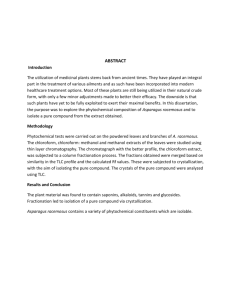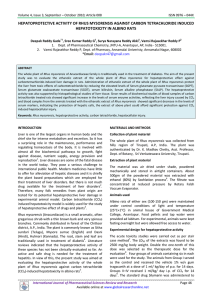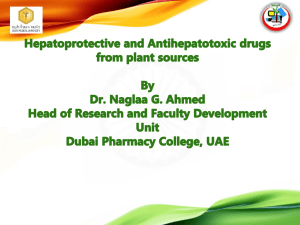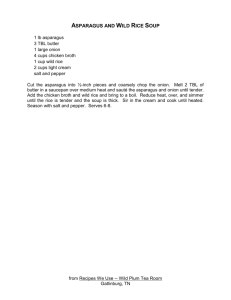Document 13310205
advertisement
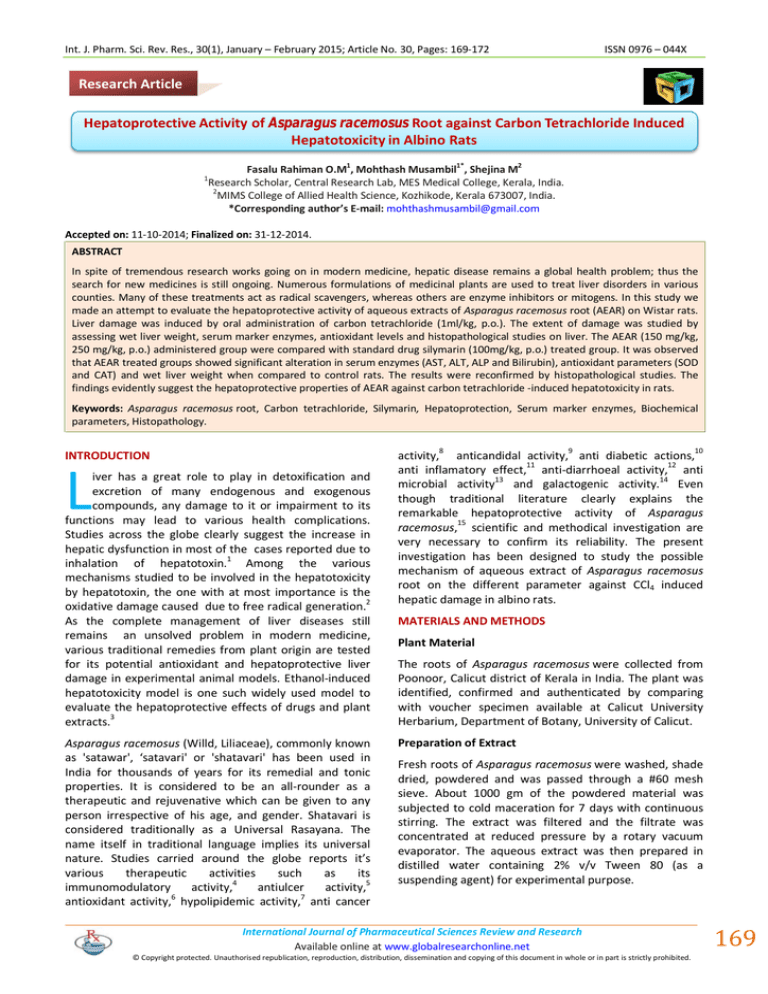
Int. J. Pharm. Sci. Rev. Res., 30(1), January – February 2015; Article No. 30, Pages: 169-172 ISSN 0976 – 044X Research Article Hepatoprotective Activity of Asparagus racemosus Root against Carbon Tetrachloride Induced Hepatotoxicity in Albino Rats 1 1 1* 2 Fasalu Rahiman O.M , Mohthash Musambil , Shejina M Research Scholar, Central Research Lab, MES Medical College, Kerala, India. 2 MIMS College of Allied Health Science, Kozhikode, Kerala 673007, India. *Corresponding author’s E-mail: mohthashmusambil@gmail.com Accepted on: 11-10-2014; Finalized on: 31-12-2014. ABSTRACT In spite of tremendous research works going on in modern medicine, hepatic disease remains a global health problem; thus the search for new medicines is still ongoing. Numerous formulations of medicinal plants are used to treat liver disorders in various counties. Many of these treatments act as radical scavengers, whereas others are enzyme inhibitors or mitogens. In this study we made an attempt to evaluate the hepatoprotective activity of aqueous extracts of Asparagus racemosus root (AEAR) on Wistar rats. Liver damage was induced by oral administration of carbon tetrachloride (1ml/kg, p.o.). The extent of damage was studied by assessing wet liver weight, serum marker enzymes, antioxidant levels and histopathological studies on liver. The AEAR (150 mg/kg, 250 mg/kg, p.o.) administered group were compared with standard drug silymarin (100mg/kg, p.o.) treated group. It was observed that AEAR treated groups showed significant alteration in serum enzymes (AST, ALT, ALP and Bilirubin), antioxidant parameters (SOD and CAT) and wet liver weight when compared to control rats. The results were reconfirmed by histopathological studies. The findings evidently suggest the hepatoprotective properties of AEAR against carbon tetrachloride -induced hepatotoxicity in rats. Keywords: Asparagus racemosus root, Carbon tetrachloride, Silymarin, Hepatoprotection, Serum marker enzymes, Biochemical parameters, Histopathology. INTRODUCTION L iver has a great role to play in detoxification and excretion of many endogenous and exogenous compounds, any damage to it or impairment to its functions may lead to various health complications. Studies across the globe clearly suggest the increase in hepatic dysfunction in most of the cases reported due to inhalation of hepatotoxin.1 Among the various mechanisms studied to be involved in the hepatotoxicity by hepatotoxin, the one with at most importance is the oxidative damage caused due to free radical generation.2 As the complete management of liver diseases still remains an unsolved problem in modern medicine, various traditional remedies from plant origin are tested for its potential antioxidant and hepatoprotective liver damage in experimental animal models. Ethanol-induced hepatotoxicity model is one such widely used model to evaluate the hepatoprotective effects of drugs and plant 3 extracts. Asparagus racemosus (Willd, Liliaceae), commonly known as 'satawar', ‘satavari' or 'shatavari' has been used in India for thousands of years for its remedial and tonic properties. It is considered to be an all-rounder as a therapeutic and rejuvenative which can be given to any person irrespective of his age, and gender. Shatavari is considered traditionally as a Universal Rasayana. The name itself in traditional language implies its universal nature. Studies carried around the globe reports it’s various therapeutic activities such as its immunomodulatory activity,4 antiulcer activity,5 antioxidant activity,6 hypolipidemic activity,7 anti cancer activity,8 anticandidal activity,9 anti diabetic actions,10 anti inflamatory effect,11 anti-diarrhoeal activity,12 anti microbial activity13 and galactogenic activity.14 Even though traditional literature clearly explains the remarkable hepatoprotective activity of Asparagus racemosus,15 scientific and methodical investigation are very necessary to confirm its reliability. The present investigation has been designed to study the possible mechanism of aqueous extract of Asparagus racemosus root on the different parameter against CCl4 induced hepatic damage in albino rats. MATERIALS AND METHODS Plant Material The roots of Asparagus racemosus were collected from Poonoor, Calicut district of Kerala in India. The plant was identified, confirmed and authenticated by comparing with voucher specimen available at Calicut University Herbarium, Department of Botany, University of Calicut. Preparation of Extract Fresh roots of Asparagus racemosus were washed, shade dried, powdered and was passed through a #60 mesh sieve. About 1000 gm of the powdered material was subjected to cold maceration for 7 days with continuous stirring. The extract was filtered and the filtrate was concentrated at reduced pressure by a rotary vacuum evaporator. The aqueous extract was then prepared in distilled water containing 2% v/v Tween 80 (as a suspending agent) for experimental purpose. International Journal of Pharmaceutical Sciences Review and Research Available online at www.globalresearchonline.net © Copyright protected. Unauthorised republication, reproduction, distribution, dissemination and copying of this document in whole or in part is strictly prohibited. 169 Int. J. Pharm. Sci. Rev. Res., 30(1), January – February 2015; Article No. 30, Pages: 169-172 Animals Albino rats of either sex (150-200 gm) were used for the study. The animals were procured and housed in the animal house maintained under standard hygienic o conditions, at 25 ± 1 C, humidity (60 ± 10%) with 12 hour day and night cycle, with food and water ad libitum. The study protocol was duly approved by the Institutional Animal Ethics Committee (IAEC) of Bharathi College of pharmacy, Bharathinagara, Mandya. Studies were performed in accordance with the CPCSEA guidelines. MATERIALS AND METHODS Hepatoprotective activity The LD50 is >1g/kg. No toxic effects or mortality were observed with doses ranging from 50mg/kg to 1g/kg for four weeks. Acute and sub acute (15-30 days administration) toxicity studies did not detect any changes in vital organ function tests (Rege et al., 1999). Hence hepatoprotective activity of alcohol extracts of Asparagus racemosus was studied by following methods. Evaluation of hepatoprotective activity ISSN 0976 – 044X analyzed according to the standard methods. The liver was removed, weighed and morphological changes were observed. A 10% of liver homogenate was used for antioxidant studies such as Superoxide Dismutase (SOD) and Catalase. A portion of liver was fixed in 10% formalin for histopathological studies. Histopathological Examination A portion of liver tissue from each group was preserved in a 10% formaldehyde solution for histopathological studies. Haematoxylin and Eosin were used for staining and the microscopic slides of the liver cells were photographed suitable magnification. Statistical Analysis The values were expressed as mean ± SEM. Statistical analysis was performed by one way analysis of variance (ANOVA) followed by Tukey multiple comparison tests. P values < 0.05 were considered as significant. RESULTS AND DISCUSSION Wet liver weight Group A - Normal control (Normal saline 10 ml/kg, p.o.) Carbon tetra chloride treatment in rats resulted in enlargement of liver which was evident by increase in the wet liver weight. The groups were treated with Silymarin and AEAR showed significant restoration of wet liver weight closer to normal values. Group B - Toxicant (CCl4 (1 ml/kg, p.o.) Effect of serum marker enzymes Group C - Served as Standard (Silymarin 100 mg/kg, p.o.) Rats treated with CCl4 developed a significant hepatic damage, which was evaluated from elevated serum levels of hepato specific enzymes like SGPT, SGOT and SALP when compared to normal control. Pretreatment with Silymarin and AEAR showed good protection against CCl4 induced toxicity to liver. Animals were divided into five groups, consisting of six animals each. The rat dose was calculated on the basis of the surface area ratio. Group D - Ethanol extract of Asparagus racemosus root (150mg/kg, p.o.) Group E - Ethanol extract of Asparagus racemosus root (250mg/kg, p.o.) For the first seven days of study Group A and B were fed with normal lab feed and water. Group C animals were treated with Silymarin (100 mg/kg) and Group D & E animals were treated orally with AEAR (150 mg/kg & 250 mg/kg) respectively for seven days. On the seventh and eighth day animals of Group B, C, D and E were administered orally with a single dose of CCl4 with 5% acacia mixture (1 ml/kg/ day). After thirty minutes of CCl4 administration Group C, D, E, F & G rats were treated with Silymarin 100 mg/kg, AEAR 150 mg/kg and AEAR 250 mg/kg respectively. On day 8, the animals were then anaesthetized using anesthetic ether and blood collected by retro orbital puncture was taken for estimating biochemical parameters. Liver tissues were removed for the determination of antioxidant enzyme levels and histopathological examinations. Total Bilirubin Measurement of Biochemical Parameters Histopathological examination of the liver section of the rats treated with toxicant showed intense effaced architecture, Apoptotic hepatocytes and congested central veins (Fig.1b). The rats treated with Silymarin (Fig. 1c) and extracts along with toxicant (Fg.1d and Fig.1e) showed hepatoprotective activity to considerable extent, Blood samples were collected from retro-orbital plexus under ether anesthesia and the serum was used for the assay of Biochemical parameters i.e., Aspartate Amino Transferase (AST), Alanine Amino Transferase (ALT), alkaline phosphatase (ALP) and Total Bilirubin were Elevation of Total Bilirubin levels after administration of CCl4 indicated its hepatotoxicity. Pretreatment with Silymarin and ethanol extract significantly reduced levels of total Bilirubin when compared to toxic control group indicating hepatoprotective effect of AEAR. Antioxidant parameters It was found that rats treated with CCl4 showed a marked decrease in activities of Catalase and Superoxide dismutase when compared to normal control group. The rats pretreated with Silymarin and AEAR showed a significant increase in the activities of Catalase and Superoxide dismutase when compared to toxicant group. Histopathology International Journal of Pharmaceutical Sciences Review and Research Available online at www.globalresearchonline.net © Copyright protected. Unauthorised republication, reproduction, distribution, dissemination and copying of this document in whole or in part is strictly prohibited. 170 Int. J. Pharm. Sci. Rev. Res., 30(1), January – February 2015; Article No. 30, Pages: 169-172 as there was absence of effaced architecture, apoptotic hepatocytes and congested central veins. CCl4 was selected as a hepatotoxicant for the present study. Our study revealed that chronic exposure to CCl4 decreased the activities of the ROS scavenging enzymes, viz. SOD and CAT. Histological examination of the liver sections suggests that the normal liver architecture was disturbed by hepatotoxins intoxication which was evaluated based on the presence of apoptotic ISSN 0976 – 044X hepatocytes and congested central veins. Treatment of rat with AEAR root exhibited regenerative changes including normal appearance of hepatic cells with nucleus and less vacuolization and fatty changes which in turn suggest the protective effect of the extract. Different parameters used for the study strongly suggest an initiation of liver regeneration process, which was reconfirmed with the biochemical parameters evaluated. Table 1: Effect of aqueous extract of Asparagus racemosus root on different parameters in CCl4 induced hepatotoxicity. Parameters Normal control Toxicant control Standard AEAR 150 mg/kg AEAR 250 mg/ kg Wet Liver Weight 2.42 ± 0.117 5.16 ± 0.111 3.52 ± 0.094*** 4.42 ±0.070* 4.05 ±0.087** SGPT 30.83±0.89 108.9±1.62 41.78±1.15*** 98.61±1.75* 65.88±0.81** SGOT 36.58±0.619 173.7 ±2.81 54.45±0.981** 154.4±1.34* 107.15±1.63** ALP 34.38±0.804 94.10±0.995 45.5±0.66*** 88.08±1.67* 61.53±0.97** Total Bilirubin 0.35±0.009 2.9±0.058 0.82±0.025*** 2.5±0.057* 1.5±0.557** CAT 92.08±1.124 21.22±0.732 80.52±1.629*** 31.918±0.697* 48.333±0.655** SOD 14.41±0.158 3.08±0.079 11.38±0.117*** 5.1±0.165** 6.58±0.095** Values are expressed as mean ± SEM (n=6) using one way ANOVA followed by Tukey Kramer’s test. Where, * represents significant at p<0.05, ** represents highly significant at p< 0.01, *** represents very significant at p<0.001 Figure 1: Histopathology of Rat liver sections. Fig. 1a represents the normal control treated group (Group A); Fig.1b represents the CCl4 treated group (Group B); Fig. 1c sylimarine treated group (Group C); Fig.1d AEAR 150 mg/kg treated group (Group D) and Fig.1e AEAR 250 mg/kg treated group (Group E) CONCLUSION This study concludes that the aqueous extract of Asparagus Racemosus willd (150 mg/kg and 250 mg/kg) shows significant hepatoprotective activity against CCl4induced liver damage rats. Hence the present study justifies the traditional use of Asparagus Racemosus willd in the treatment of liver diseases. REFERENCES 1. Reddy PB, Reddy CK, Rambhau D, Hepatoprotective activity of the leaves of Nyctanthes arbor-tristis Linn, Indian J Pharm Sci, 55,1993,134. 2. DeLeve LD, Kaplowitz N, Mechanisms of drug induced liver disease,Gastroenterol clin N Am, 24, 1995, 787-810. 3. Panda BK, Mishra US, Antibacterial activity of the leaves of Cocculus hirsutus. Indian Drugs, 44, 2007, 108-10. 4. Rege NN, Thatte UM, Dahanukar SA, Adaptogenic properties of six rasayana herbs used in Ayurvedic medicine,Phytother Res, 13, 1999, 275-291. 5. Singh KP, Singh RH, Clinical trial on Satavari (Asparagus racemosus Willd.) in duodenal ulcer disease, J Res Ay Sid, 7, 1986, 91-100. 6. Wiboonpun N, Phuwapraisirisan P, Tip-pyang S, Identification of antioxidant compound from Asparagus racemosus, Phytother Res, 78, 2004, 771-773. 7. Visavadiya NP, Narasimhacharya. Hypolipidemic and antioxidant activities of Asparagus racemosus in International Journal of Pharmaceutical Sciences Review and Research Available online at www.globalresearchonline.net © Copyright protected. Unauthorised republication, reproduction, distribution, dissemination and copying of this document in whole or in part is strictly prohibited. 171 Int. J. Pharm. Sci. Rev. Res., 30(1), January – February 2015; Article No. 30, Pages: 169-172 hypercholesteremic rats. Indian Journal of Pharmacology 2005; 37: 62-68. 8. 9. Rao AR, Inhibitory action of Asparagus racemosus on DMBA-induced mammary carcinogoenesis in rats, Int J Cancer, 28, 1981, 607-10. Uma B, Prabhakar K, Rajendran S, Anticandidal activity of Asparagus racemosus, Indian Journal of Pharmaceutical Sciences, 71, 2009, 342-343. 10. Kar A, Choudhary BK, Bandyopadhyay NG, Preliminary studies on the inorganic constituents of some indigenous hypoglycaemic herbs on oral glucose tolerance test, J Ethnopharutacol, 64, 1999, 179-184. 11. Mandal SC, Mukherjee PK, Nandy A, Pal M, Saba, Some pharmacognostical characteristi of Asparagus racemosus Willd roots, Ancient Sci Life, 15, 1996, 282. ISSN 0976 – 044X 12. Venkatesan N, Thiyagarajan V, Narayanan S, Arul A, Raja S, Kumar SG, Rajarajan T, Perianayagam JB, Anti-diarrhoeal potential of Asparagus racemosus wild root extracts in laboratory animals, J Pharm Pharm Sci, 8, 2005, 39-46. 13. Ahmad N, Mehmood Z, Mohammad, Screening of some Indian medicinal plants for their antimicrobial properties, J Ethnopharmacol, 62, 1998, 183-19. 14. Nadkarni AK, Indian Materia Medica, First Volume, Popular Book Depot, Bombay, 1954,120-134. 15. Gupta M, Shaw B, A Double-Blind Randomized Clinical Trial for Evaluation of Galactogogue Activity of Asparagus racemosus Willd, Iranian journal of pharmaceutical research: IJPR, 10, 2011, 167. Source of Support: Nil, Conflict of Interest: None. International Journal of Pharmaceutical Sciences Review and Research Available online at www.globalresearchonline.net © Copyright protected. Unauthorised republication, reproduction, distribution, dissemination and copying of this document in whole or in part is strictly prohibited. 172
